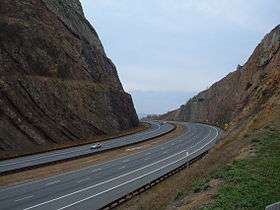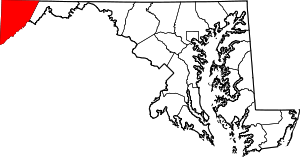Western Maryland

Western Maryland is the portion of the U.S. state of Maryland that traditionally consists of Washington, Allegany, and Garrett counties,[1] with western portions of Frederick County also associated with the area. The region is bounded by the Mason-Dixon line to the north, Preston County, West Virginia to the west, and the Potomac River to the south. There is dispute over the eastern boundary of Western Maryland. For most residents of the Baltimore-Washington area, everything west of Frederick city is considered Western Maryland. However, the people of the more mountainous and isolated Allegany County and Garrett County consider Sideling Hill the boundary between Western Maryland and what they refer to as "down-state."
Western Maryland is much more rural than the Baltimore-Washington Metropolitan Area, where most of the state's population lives; even Frederick and Washington counties are less urbanized than places closer to Washington, D.C., and Baltimore. There are relatively few towns larger than 10,000 people. Western Maryland is noted for its idyllic rural landscapes in its eastern portion and the mountainous terrain. The area is generally regarded as part of Appalachia,[2][3] with the extreme western section having more of an affinity to Pittsburgh than the rest of the state. Washington, Allegany, and Garrett counties are part of the Appalachian Regional Commission. Garrett County, the state's westernmost county, largely aligns itself through marketing and sports with West Virginia and the Pittsburgh area rather than Maryland.
The four most western counties of Maryland, from eastern Frederick County to western Garrett County, span approximately 120 miles (190 km).[4]

Climate
The climate of Western Maryland is more akin to the mountains of northern West Virginia than to any other part of Maryland. Summers tend to be much cooler than in the rest of the state, and winters harsher. Temperatures in winter drop to below 0 °F (−17.8 °C) on around eight nights per winter, and snowfall averages from 20 inches (0.51 m) farther east to over 120 inches (3.05 m) in the higher elevations. Comparably, Prince George's County, in the eastern part of the Washington, D.C., area, averages only 25 inches (0.64 m) of snow and wintertime maxima exceed 50 °F (10 °C) on a third of all days.
History
In 1748, the Western Maryland population was finally large enough to create a new county called Frederick County. Hunters and traders had been in Western Maryland as early as 1715, but there were not many attempts at settlements for years after that in more remote parts of the area. 1768 had many emigrants that began to settle in the Western Maryland, Western Pennsylvania, and Western Virginia areas. In the earliest part of the colonial days, German immigrants that came from Pennsylvania had the most influence on the development of the plains and valleys of Western Maryland.[5]
Named for George Washington, Washington County was founded in 1776, by division of Frederick County. In 1862 during the civil war, this county was home to one of the bloodiest single-day battles at Antietam National Battlefield. The largest city in this county is Hagerstown. It was named after Jonathan Hager, a German settler.[6]
In 1785, the city of Cumberland, which is in Allegany County, was established. The County was the home for many pioneers, when they would travel through the Cumberland Narrows, a 1,000 foot high gap. This gap forms the main pass through the Allegheny Mountains to the west. In the mid-18th century, English settlers came to the county and began to mine and create towns and farms. This county was important for transportation for many travelers heading west. They would pass through by many forms of transportation, including canal, train, and horse and buggy.[6]
The most western county in the state, Garrett County, was the last part of Maryland to be settled in 1764. The county was founded in 1872 by John Work Garrett, the B&O Railroad president.[6]
Demographics
According to the 2010 U.S. Census,[7] the three westernmost counties of Maryland have a population of 252,614, accounting for 4.4% of the population of Maryland.
The most populated county is Washington County, which has an approximated 147,430 people. Allegany County is the next most populated county with 75,087 people, and Garrett County is the smallest with 30,097 people.
Economy
Western Maryland has a heavily agricultural economy. Its best-known crops are the apples grown in the Cumberland Valley, but corn, potatoes, beans, and varieties of green-leaf vegetables are grown as well. Mixed crop and livestock farms are common, and the region has a large number of dairy cattle farms. There is however, a thriving tourist industry, and places such as Deep Creek Lake in Garrett County are frequented by many visitors every year. Garrett County is also well known for its numerous state parks and outdoor activities. Maryland's only ski resort, Wisp Ski Resort, is located in Garrett County near Oakland.
Appalachian Development Plan
The Appalachian Regional Development Act was created and passed in 1965 in an effort to correct the poverty issue, and the growing economic problems in the Appalachian region (13 States). According to the State of Maryland Appalachian Development Plan,[8] the Act was passed because: (1) One in every three Appalachians lived in poverty; (2) Per capita income was 23% less than the US average; and (3) High unemployment and harsh living conditions had, in the 1950s, forced more than 2 million Appalachians to leave their homes and seek work in other regions.
For the state of Maryland, this act was intended to bring awareness to the poverty levels of the Western Maryland counties. The program that was developed for this act was called the Appalachian Regional Commission (ARC), and former governor Martin O'Malley was appointed to be the Maryland representative in 1971. The main goal of the ARC was to improve the development of the economy, and bring this region into socioeconomic parity with the rest of the nation.
Tourism
Tourism is very important to Western Maryland and railroads were a big part of that in the 19th century. From the University of Maryland Overview of Western Maryland, "Tourism, second home development, and retirement housing have the potential for significant growth. Second home development is particularly noticeable in the Deep Creek Lake recreational area of Garrett County, but the arrival of retirees from more metropolitan counties has been noted in several of the counties."[9]
The largest lake in Western Maryland is Deep Creek Lake in Garrett County. The 4,000 acre body of water is owned by the State of Maryland and is man made. Construction began in 1920 and the lake was filled by 1929. It was originally made to power a small scale hydroelectric plant, but was eventually turned into a tourist destination. The lake is currently managed for boating and fishing, although it still provides some water to generate electricity. The Deep Creek Lake State Park offers fishing piers, beach and swim area, covered pavilions, and opportunities for camping.[10]
Wisp Ski Resort is a huge tourism spot in Western Maryland as it is the only 4 season ski, golf, and recreational destination resort. This resort is approximately 172 acres which includes a mountain coaster, cross country skiing, snowmobiling, and more.[11]
County populations
| Core Based Statistical Area | 2010 Census | County | 2010 Census |
|---|---|---|---|
| Hagerstown-Martinsburg, MD-WV MSA | 269,140 147,430 |
Washington County, Maryland | 147,430 |
| Berkeley County, West Virginia | 104,169 | ||
| Morgan County, West Virginia | 17,541 | ||
| Cumberland, MD-WV MSA | 103,299 75,087 |
Allegany County, Maryland | 75,087 |
| Mineral County, West Virginia | 28,212 | ||
| none | Garrett County, Maryland | 30,097 | |
Major communities
- Boonsboro
- Brunswick
- Cumberland
- Frostburg
- Hagerstown
- Hancock
- Middletown
- Mountain Lake Park
- Oakland
- Smithsburg
- Westernport
- Williamsport
Education
Colleges in Western Maryland include:
- Garrett College – Community College
- Allegany College of Maryland – Community College
- Frostburg State University
Potential state
In 2014, it was reported that some residents want the region to form a new state. Possible names for such a proposed state include Liberty, Antietam, and Augusta.[12] Local supporters of partitioning western Maryland (dubbed "the Western Maryland Initiative") cited a perception of political domination by the more populous eastern portion of the state, particularly with reference to such issues as gun control, taxation, and same-sex marriage.[13]
See also
Notes
- ↑ "Maryland Regions". Visit Maryland. Retrieved 21 January 2014.
- ↑ Hazen, Kirk (2000). "The Appalachian Language Bibliography". Retrieved 2007-12-08.
- ↑ Hogg, Richard M.; Denison, David (2006). "A History of the English Language". Cambridge University Press: 386–387. ISBN 0-521-66227-3. Retrieved 2007-12-08.
- ↑ "Western Maryland Guidebook" (PDF). Retrieved 30 July 2014.
- ↑ Scharf, J. Thomas. History of Western Maryland. Philadelphia : L. H. Everts. pp. 59–61. Retrieved 30 July 2014.
- 1 2 3 "Maryland Regions". Visit Maryland. Retrieved 9 August 2014.
- ↑
- ↑ "State of Maryland Appalachian Development Plan" (PDF). Retrieved 11 August 2014.
- ↑ "Western Maryland Overview of Regional Trends and Issues" (PDF). Retrieved 9 August 2014.
- ↑ "Deep Creek Lake". Maryland.gov. Retrieved 10 August 2014.
- ↑ Wisp Resort http://www.wispresort.com. Retrieved 9 August 2014. Missing or empty
|title=(help) - ↑ "Some Western Maryland Residents Want To Form Their Own State". Retrieved 2014-02-11.
- ↑ "Western Maryland secessionists seek to sever ties with the liberal Free State", The Washington Post, by Michael S. Rosenwald (September 8th, 2013; retrieved on November 12th, 2014).
External links
| Wikivoyage has a travel guide for Western Maryland. |
- Western Maryland Scenic Railroad Official Website for the Scenic Railroad and Canal Place.
- Walkersville Southern Railroad website, see also Walkersville Southern RR wiki article
- Western Maryland Tourism Website MDMountainside.com
- Rocky Gap Resort Western Maryland Park with Lake & Golf Course
- Heritage Days Festival
- Canal Place
- Queen City Striders Running Club
- Western Maryland Mountain Bike Association
- Western Maryland Water Color Society
Coordinates: 39°41′40.23″N 77°52′15.94″W / 39.6945083°N 77.8710944°W



